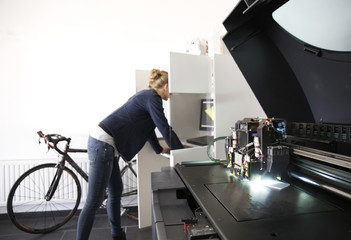How thin can a 3d printer print? 3D printing, or additive manufacturing, is a transformative technology that enables the creation of three-dimensional objects from a digital file. Its applications span across various sectors, including healthcare, automotive, education, and even food production. The technology offers numerous benefits, such as rapid prototyping, customization, reduced waste, and cost-effectiveness.
Understanding Layer Height in 3D Printing
Layer height is a critical concept in 3D printing. It refers to the 3d printing minimum wall thickness of each individual layer of filament that a 3D printer lays down to create an object. Layer heights are typically measured in microns (µm), with 1 micron being equal to 0.001 millimeters. Common layer heights range from 50 to 300 microns, but they can be adjusted based on the requirements of the print job.
The Impact of Layer Height on Print Quality
The layer height has a significant impact on the quality of the final print. Lower layer heights (i.e., thinner layers) generally result in prints with finer details and smoother surfaces. However, they also increase the printing time significantly. On the other hand, higher layer heights (i.e., minimum wall thickness 3d printing layers) produce prints faster, but the resulting objects may have visible layer lines and less detail.
Choosing the Right Layer Height
What is a good layer height for 3d printing? Choosing the correct layer height depends on what you value more in your project: detail or speed. If you’re creating a detailed miniature model, for example, a lower fdm layer height would be beneficial. Conversely, if you’re printing a large, less detailed object, a higher layer height will save you time.
Optimal Layer Heights for Different Materials
What is layer height in 3d printing? Different materials used in 3D printing may require different optimal 3d printing layer height. For instance, Polylactic Acid (PLA) and Acrylonitrile Butadiene Styrene (ABS) work well with layer heights ranging from 100 to 300 microns, while Polyethylene Terephthalate Glycol (PETG) is often printed with a layer height of 200 to 300 microns. Always refer to the material manufacturer’s recommendations when deciding on layer heights.
How to Adjust Layer Height in 3D Printing Software
Adjusting the layer height is a straightforward process in most 3D printing software. In slicing software like Cura or Simplify3D, you can find the layer height setting in the print setup or process settings menu. After entering your desired layer height, the software will recalculate the print time and material usage for you.
Common Issues Related to Layer Height and Their Solutions
Incorrect layer height can lead to several issues, including poor surface quality, weak part strength, and excessive print times. If you’re experiencing these problems, try adjusting your layer height. For poor surface quality or visible layer lines, try reducing the layer height. If your prints are weak or breaking easily, consider increasing the layer height for added strength. And if your prints are taking too long, a higher layer height can speed up the process.
What is a good wall thickness for 3d printing?
3D printer wall thickness largely depends on the type of material used and the purpose of the printed part. However, a good general rule is to aim for a wall thickness of at least 1mm. This should provide a sufficient amount of strength while also allowing for a good level of detail in the printed part. For parts that need to be more durable or are larger in size, you may want to consider a thicker wall, perhaps around 2-3mm. Always remember to check the specifications and guidelines provided by your 3D printer manufacturer or filament provider to ensure optimal results.
Differences between FDM layer height, resin printing layer height and
resin printer layer height
The layer height in 3D printing is a critical factor that determines the quality, strength, and print time of the final product. There are notable differences between the layer heights used in Fused Deposition Modeling (FDM) printing and resin printing.
FDM printing is a popular type of 3D printing technology that builds objects layer by layer from a plastic filament. The layer heights in FDM printing typically range from 0.05mm to 0.4mm, with 0.2mm being the most common1. The layer height in FDM printing is influenced by factors such as the nozzle diameter, which can be as wide as 2mm, but a diameter of 0.8mm offers significantly faster printing while remaining relatively practical.
On the other hand, resin printing, also known as Stereolithography (SLA) printing, uses a liquid resin that is cured by light to create objects. The standard layer height in resin printing is around 50 microns (0.05 mm), which is about a quarter that of FDM printing. This smaller layer height allows resin printers to produce highly detailed prints. However, it’s worth noting that the printing time in resin printing is not affected by the number of objects being printed, unlike in FDM printing1.
So, whether you choose FDM or resin printing will depend on your specific needs. If you require high detail and precision, resin printing may be the better option. But if speed and practicality are more important, then FDM printing could be the way to go.
Maximizing Your 3D Prints with Layer Height
How thin can 3d printers print? Understanding and correctly setting the layer height is fundamental to achieving high-quality 3D prints. By considering factors such as print detail, speed, material type, and common issues, you can effectively use layer height to optimize your 3D printing projects. As you gain more experience, you’ll be better able to fine-tune your layer height settings to suit your specific needs.



